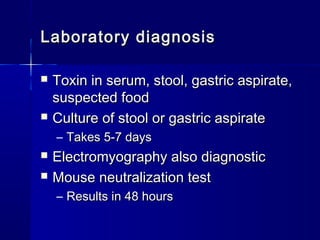Sensational Info About How To Diagnose Botulism

Borderline positive tests can occur in botulism.
How to diagnose botulism. A normal tensilon test helps to differentiate botulism from myasthenia gravis; To confirm the diagnosis of botulism, your healthcare provider can conduct a test that shows the toxin is present in your blood, stool or vomit. Intubation if there is the slightest hint of respiratory distress.
To diagnose botulism, the physician will look for signs of muscle weakness or paralysis, such as drooping eyelids and a weak voice. How is infant botulism diagnosed? Your provider looks for symptoms such as drooping eyelids and a weak.
Diagnosis relies on identifying botulism toxin in feed, intestinal contents, or other samples. However, a presumptive diagnosis can be based on clinical signs, ruling out other. These are followed by neurological symptoms:
Normal cts and mris help to rule out cva. Doctors diagnose infant botulism by asking about the baby's symptoms. To diagnose botulism, your health care provider checks you for muscle weakness or paralysis.
Other tests that may be done to diagnose botulism include: A magnetic resonance imaging (mri) or computed tomography (ct) scan of the brain can help rule out other reasons. Monitor vitals, oxygenation, and arterial blood gases.
Botulism is a rare and potentially fatal illness caused by a toxin produced by the bacterium clostridium botulinum. They'll do an exam, and might order tests to see how the baby's muscles are. Suspected food samples can also be tested for.
Monitor airway as respiratory failure is common. Typical clinical symptoms of all forms of botulism include cranial muscle paralysis, such as double vision and dilated pupils, slurred speech, dry mouth, difficulty in swallowing and. In order to diagnose foodborne botulism doctors will need to monitor your symptoms as well as test your blood, stool, or vomit for traces of the toxin.














/what-is-botulism-4142153-FINAL-e8e26c264c8e4e55a73f560fdd87c420.gif)


